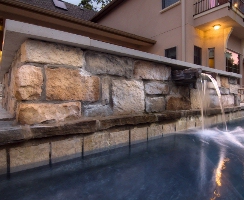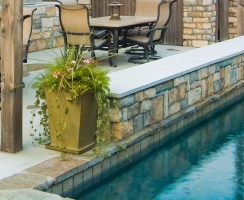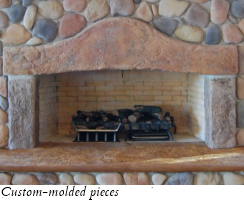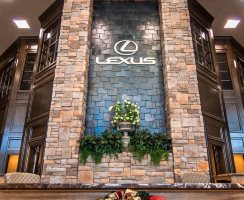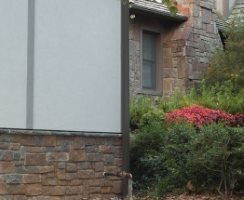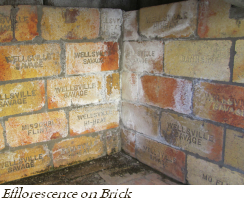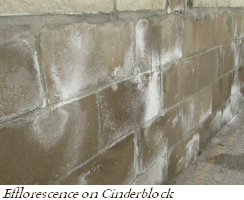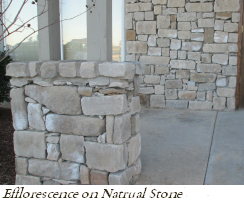Frequently Asked Questions

I’ve never heard of “manufactured stone”. Is this a new product? 
Actually, this product has been around for several decades. Despite this fact, it is surprising just how few people—even builders—realize that this product exists and that it makes a wonderful alternative to the real thing. Significant advances in the manufacturing process have improved both the quality and the appearance of manufactured stone, along with lowering the cost. It can be used in just about any sort of building project—commercial/residential, new construction/remodeling, interior/exterior, and landscaping.
What are some of the more common uses for manufactured stone? 
Most people use it to enhance the exterior appearance of their home, office, or commercial building. But we provide stone for a lot of other kinds of projects too, like interior fireplaces and accent walls, outdoor kitchens, retaining walls, wine cellars, and so forth.
Are there any special maintenance requirements? 
No, our products are designed to be essentially maintenance-free. You would maintain them the same way you maintain brick or stone—with an occasional wash to remove surface dust and debris. If you are using our stone on an interior project, a light feather dusting from time to time should be all that is necessary.
Why is manufactured stone a good option? 
Just about everybody loves the look of natural stone. But real stone is extremely heavy, expensive, and time consuming to build with. Our stone gets around all of these limitations… it’s kind of like 3-dimensional wallpaper, and any sturdy wall will do. Plus, since we make it custom to order in our Tulsa facility, you can get colors and styles that you’d be hard pressed to find anywhere else, including exclusive colors to fit your specific design needs. You can also use it in places where natural stone just won’t work, particularly in interior applications like kitchens or decorative walls.
What exactly is manufactured stone, and how do you make it? 
Manufactured stone is a cast concrete product that is designed to look and feel like the real thing. The process starts with the creation of a set of rubber molds. Our mold vendor carefully selects high-quality, representative natural stones with varying shapes and textures—the kind that will give lots of visual interest to your finished project. These natural stones are used as masters to create our molds. Once the molds are ready, we prepare a mixture of Portland cement, lightweight aggregate, water, and iron oxide color pigments, and then pour this mixture into the molds. We use a number of techniques to achieve the coloring and shade variations that each customer wants. Once the mixture dries, we remove the finished stone product from the mold. We then cure the finished product for a period of several days, and finally ship it to your project location.
What form does the finished product take—do I get individual stones or is it pre-formed into some sort of panel? 
Most of our Stone Styles are delivered as individual stone units, just as if you had purchased natural stone. Our QuickFit product is the only exception, as it features a “panelized” look that simulates Ledgestone through a series of rectangular pieces with multiple stone impressions per piece.
What about pattern repetition? 
Our molds provide at least 100 square feet of finished product without repeating. This ensures that your project will achieve the look of natural stone with no noticeable pattern repetition. Of course, your installer must also strive to avoid grouping large numbers of similarly sized/shaped stones together to achieve the best results.
Where can I go to see how your stone is being used? 
We suggest that your first stop should be our showroom where we can show you our stone samples and photos of projects we’ve done. When you come, please bring any items that you’ve already selected for your project, such as brick, tile, shingles, and so forth. Our personnel can help you identify the Stone Styles and Color Schemes that will best complement your selected project materials. If you have photos of stone projects that you like, bring them in as well so we can help you find or create a close match. Once we’ve narrowed down your options a bit, we may be able to direct you to nearby projects that have used the product(s) you are considering.
And of course, you can check out our Gallery to see lots of finished projects. Each commercial project features an address and a Google map so you can go check it out in person. Just click the “Project Location” link on the Project page.
What kind of cost am I looking at for a complete project—materials, labor, etc? 
This question is rather difficult to answer, because we really have to fall back on the old “it depends” routine. But let’s start with the big picture… you basically have three choices when it comes to attractive, three-dimensional surfacing options: brick, natural stone, and manufactured stone.
Of these three options, brick is going to be the most cost-effective in virtually any circumstance. The only real exception might be an interior application where a suitable foundation does not already exist (a second floor fireplace, for instance). Brick is very heavy and it requires a solid foundation to support its weight. If a foundation needs to be built to support the project, the project cost can go up dramatically.
Next on the cost-effectiveness scale is manufactured stone. The product is classified as an “adhered veneer” due to its light weight (approximately 8-10 pounds per square foot). As such, it requires no footings, wall ties, or foundations and is therefore ideal for both interior and exterior applications. It can be applied to any properly prepared, structurally sound wall surface such as wood, wallboard, masonry, or metal. So there are almost never any “hidden costs” associated with installing the product. On the other hand, the product generally requires some surface preparation. It also calls for an installer with a fair amount of artistic skill to achieve a high-quality, visually appealing result.
Last is natural stone, which is extremely heavy (thus requiring a suitable foundation, as with brick) and requires a highly skilled installer (even more so than with manufactured stone). In addition, if the stone you want is not indigenous to your local area, you’ll pay premium shipping charges to get it to your project location. It also takes much more time to install than brick or manufactured stone—because of the weight, installers must lay a couple of feet, then allow the section to fully set up before continuing with the next section. A project that takes just a few days with brick or manufactured stone will take weeks with real stone. Thus, its only real advantage to natural stone is the ephemeral satisfaction of knowing that it is indeed “natural”.
What about numbers? Each project is different and will require a quote from a qualified installer. That said, here are some broad price ranges:
| Material | Basic Material Cost | Installed Cost | Brick | $3.00 - $4.00 per sq ft | $7.00 - $8.00 per sq ft |
| Manufactured Stone | $4.95 per sq ft | $9.50 - $12.50 per sq ft | ||
| Natural Stone | $3.50 - ??? per sq ft | $14.00 - $25.00+ per sq ft |
I like the “stacked stone” look. Do I have to use a grout line with your products? 
Using a grout line produces a traditional, more formal look, while the drystack (i.e., no grout line) technique produces a more rustic look that is very popular these days. Our Cobblestone, Hackett, and Ledgestone styles can be installed with or without a grout line according to your aesthetic preference. Our QuickFit product can only be drystacked. Our Fieldstone and River Rock styles cannot be drystacked due to the shape irregularities inherent in these styles.
Do I have to put on a scratch coat before I start installing the stone? 
A scratch coat is a thin layer of masonry mortar that is applied to the lath wire and allowed to dry overnight. This creates a hard, flat, smooth surface to attach the stones to. While there is no universal agreement on the necessity of a scratch coat, most professional installers use one. A good reason for this is that sometimes the lath can buckle if it is not secured very snugly to the wall surface, and if it does buckle, the movement can cause a newly placed stone to fall off the wall. Another reason is that it can be difficult to place stone units—especially Ledgestone units—in areas where two pieces of lath overlap. So the scratch coat can make the installation process go a bit more smoothly. But as far as the structural soundness of your project is concerned, a scratch coat is really optional.
How long does it take to install? 
Manufactured stone installation requires a bit more time than brick, but substantially less time than natural stone. As a general guideline, a seasoned installation professional can cover about 100 to 150 square feet of surface area per day.
Do you offer any guarantee if we choose one of the installers listed on your Installation page? 
The short answer is no. We cannot make any guarantees that you will achieve your preferred outcome if you use one of the specialists featured on our website.
We provide a list of installers as a convenience to our customers, and to recognize those installers who have used our stone on their projects. We encourage you to use our Gallery to get a sense of the craftsmanship you can expect to receive from a featured installer. We also suggest that you visit these projects to inspect their work up close.
All of these professionals are independent business people. We have no financial relationship with ANY of them. We never receive any sort of financial compensation from anyone who installs our stone. Furthermore, we never “discount” our pricing to these installers or any other intermediary.
Your outcome rests solely upon your ability to work productively with your chosen installer, so please choose carefully.
Do you have a set of architectural specification documents for submittals? 
Yes, we do. Please click this link to access our Product specifications:
Impressions in Stone Submittal Documents
Please click this link to access architectural-grade Installation specifications from the Masonry Veneer Manufacturer’s Association (MVMA):
Installation Guide and Detailing Options for Compliance with ASTM C1780
Has your product received any sort of ASTM certification? 
The short answer is no, not formally. But there’s considerably more to the story…
We received our first inquiry on this topic in the early days of our company, back in 2005. Specifically, the customer wanted certification on the following:
- Freeze/Thaw: ASTM C 67
- Shear Bond Strength Test: ASTM C 482
- Compressive Strength: ASTM C 39 and C 192
- Fire Hazard Test: UL 723 where the Flame Spread = 0 and Smoke Development = 0
- Thermal Resistance: ASTM C 177
In order to achieve certification, our material would have been subjected to a battery of tests and processes specified in each applicable ASTM standard. An independent testing facility offered to perform these tests at a cost of around $10,000. We felt this cost was prohibitive, and declined to proceed.
However, we learned that the most critical certification was the Freeze/Thaw test under ASTM Designation C 67. We purchased the test procedures under Designation C 67—03a from the ASTM and conducted our own evaluation. After carefully following the test procedures for a period of 60 days, all of our test specimens showed no weight loss, no breakage, and no cracking. This evaluation was satisfactory to the customer, and they proceeded to use our stone on their project, which you can see here: Bixby First United Methodist Church.
Over the years, we have received only a handful of inquiries from prospective customers about our material certification status. In almost all of those cases, lack of certification did not hinder the ultimate purchase of our material, so we concluded that formal ASTM certification would not be a productive investment for our business.
Frankly, we are not impressed with the ASTM certification process. In order for the testing to be valid, a manufacturer is expected to supply a “random sampling” of specimens to the testing agency. Unfortunately, there is no way for the testing agency to know for certain whether supplied specimens truly are representative of a manufacturer’s finished product. Given the expense of these tests, any manufacturer would be motivated to supply a set of specimens guaranteed to pass the test—which may or may not have been made in accordance with the manufacturer’s normal concrete mix design. Consequently, there is no independent verification from the ASTM that the test wasn’t “rigged”.
At the end of the day, what you get from the ASTM is a piece of paper that says, “Theoretically, this company’s material is good.” That piece of paper may look impressive, and it may provide a convenient measure of assurance, but we don’t consider it to be truly valuable. Instead, we recommend evaluating a manufacturer’s products by considering the company’s body of work over time. Our body of work features thousands of projects and many millions of dollars in product sales. We encourage you to visit any of our projects that were completed 10 to 15 years ago, many of which are featured in our Gallery. If you like what you see, then you can choose us with confidence.
Can you measure my architectural drawings and provide a take-off estimate? 
The short answer is yes we can, but with a few caveats.
First, the good news... we don't offer “quantity discounts”, so our unit pricing applies to all purchases regardless of the quantity.
Now for the bad news... we don’t like preparing take-off estimates because unless we get the number exactly right (which is extremely unlikely), then we have a potential point of conflict. If we underestimate, it might appear that we deliberately did so to secure your business with an enticing project price. If we overestimate, it might appear that we purposely sold you more stone than you needed. So providing take-off estimates carries risks for us.
We think that the best idea is to have your installer provide you with a quantity estimate based on the actual building structure rather than architectural drawings. This generally allows for a more accurate estimate, and removes the conflict of interest between you and us.
Of course, if you can’t wait until the structure is actually built to get your estimate, then a take-off is your only option. If your builder, installer, designer, or architect is not able to prepare the take-off estimate, then we would be willing to do so if you keep these points in mind:
- We are not experts at blueprint reading. The quantities we calculate represent our very best “guesstimates” and are provided with no guarantee of accuracy.
- You must provide us with to-scale paper printouts of all floor plans and elevations clearly indicating where our stone is to be used.
- Our Estimate is not a “bid”. If you need more of our products to complete a project, all additional quantities will be billed at the same Unit Price quoted on your original Estimate form.
- You may wish to order more or less than our estimated quantities based upon your priorities. For example, if cost management is your top priority, then we suggest ordering less than the estimated quantities. When the project nears completion, your installer can get a very good estimate of the remaining quantity requirements, which we can then begin to make. On the other hand, if timeliness is your top priority, then we suggest ordering more than the estimated quantities to minimize the risk of a time lag in producing your final “catch-up” order.
How far out from the substrate does the completed stone surface extend? 
Our stones average about 1¼ inches in thickness, plus or minus about ¼ inch. By the time you get the felt paper, the lath, the mortar, and the stones attached, the total thickness of the completed stone surface is about 1¾ to 2 inches deep.
How does manufactured stone hold up over time? 
The product is just about as durable as any surfacing product you can buy. Our stone products are designed to provide many years of service with no noticeable discoloration or surface texture degradation. We are so confident in the quality and soundness of our products that we offer a 50-Year Limited Warranty.
Does the color go all the way through your stone? 
The short answer to this question is… Yes and No!
When customers ask us this question, it usually stems from one of two concerns. The first concern might best be stated as, “Is your stone colorfast?” The answer to this question is always Yes.
We use 4 different coloration techniques in our manufacturing process, all of which employ dry-form iron oxide color pigments:
- Solid: The pigment is integrally mixed into the “background” concrete itself.
- Swirl: One color pigment is integrally mixed into a “background” concrete, while another color pigment is integrally mixed into a “highlight” concrete. The two are then loosely mixed together.
- Spray: The pigment is mixed into a liquid form and applied to the surface of the molds prior to pouring in the concrete.
- Powder: The pigment is mixed into a dry form and applied to the surface of the molds prior to pouring in the concrete.
These coloration techniques provide very different aesthetic values. Solids are essentially uniform in color, with little variation from stone to stone, producing a monochromatic effect. Swirls provide a “marbled” effect, often with considerable variation from stone to stone in the same batch. Sprays produce a sort of “glowing” effect, because pouring wet concrete into a spray colored mold often pushes the liquid towards the extremities of the mold, creating areas of high and low color intensity. Powders yield a rough, craggy, jumbled-up sort of appearance, such as you might see in natural granite. Intuitively, Sprays and Powders may seem to carry potential risk with regard to colorfastness. But if the pigments are prepared correctly, then they are every bit as colorfast as Solids and Swirls.
Our Color Schemes are made up of one or more color elements, each of which may employ any or all of the coloration techniques described above. For example, our Cashmere-Gray color element uses a cream-colored Solid “background” and a black-colored Spray “highlight”. So the cream color goes all the way through, while the black color exists only on the surface of the stone.
Regardless of coloration technique, the bottom line is that all of our products are guaranteed to be colorfast.
The second concern might best be stated as, “What happens if the stone is damaged?” For this concern, it actually makes no difference whether the color goes all the way through or not. If the stone itself incurs physical damage after it is installed, you will see the exposed aggregate that makes up about 90% of the concrete matrix. The aggregate itself cannot be colored in any way, so what you perceive will almost certainly not resemble the stone’s original surface coloration, regardless of whether the color pigment permeates the cement paste. Fortunately, a skilled installer can remove damaged stones from your wall surface relatively easily, and then replace them with undamaged stones.
Do I have to apply a sealer to your products? 
Because our product is made of concrete, it will absorb water just like any other concrete surface. Over time, the repeated absorption of water in a freeze/thaw cycle may potentially cause permanent damage to the stone. A sealer theoretically helps to close the pores in the concrete, thereby repelling the water rather than allowing it to be absorbed.
Since manufactured stone is reserved for use in vertical (wall) applications, water and ice usually don’t have the chance to sit on the surface long enough to cause a problem. Stone laid at ground level, however, may be at greater risk.
Is a sealer an absolute must? Our experience leads us to believe that it is not. Is it a good idea? In implementations where standing water could potentially cause a problem, it may be a good idea. However, our research indicates that certain impregnating, hydrophobic sealers may actually LEAD to damage from freeze/thaw cycles, so you must be very careful when reviewing your options.
If you elect to use a sealer, industry standards recommend that you always use a high-quality, breathable (i.e., non-filming) masonry sealer in strict accordance with the manufacturer’s instructions. And be sure to test your sealer on a small portion of our stone to ensure that the final appearance is what you’re looking for.
Can I use your products on wall areas adjacent to swimming pools? 
Our products will hold up at least as well as any other high quality, lightweight concrete material in this application. If you wish to use our products in this type of application, we recommend that you apply a breathable masonry sealer to the finished surface. However, please remember that any material—concrete or natural—will eventually fade due to continued exposure to chlorine and other chemicals. We do not recommend using our products in salt-water pools, as the salt has been known to wear away the surface of manufactured stone.
If I bring you a mold, will you make a custom piece for me? 
Over the years, many of our customers have asked us to make “specialty” pieces by pouring our concrete into custom molds that they provide. We are a bit reluctant to do this, because we don’t have the expertise needed to guarantee a desirable outcome for the customer. But we don’t like to tell our customers “No” without even trying, so we generally accept the assignment with the understanding that the customer is 100% responsible for the outcome. This means we will not process a refund of the purchase price if the customer is dissatisfied in any way. If you’re thinking of asking us to make a special piece for you, here are some things to keep in mind:
- We cannot provide guidance to you on how to make your mold, because we simply don’t know how to make molds. Further, we will not modify your mold in any way once we receive it.
- Your molds should not be very large or very thin. Our concrete weighs about 10lbs per square foot, so large pieces will be extremely heavy, and are far more likely to break in transport or handling.
- We cannot provide any special ingredients or processes to enhance our standard concrete mix, because we have no expertise in mix design. If you want us to fortify your piece, you must provide the materials and instructions.
- Our concrete mix is relatively wet, but little air pockets (i.e., “bug eyes”) may form on the top of the piece anyway. We will try to jiggle your mold as best we can while we are pouring the concrete, but we can’t guarantee a flawless finish.
- We will not de-mold your piece once the concrete has set up. You may de-mold your piece at our shop if you like. You may also wish to leave the piece in the mold to guard against breakage during transit.
- You must allow the piece to dry completely before making any assessments with regard to coloration. The curing process may take several days.
- We can’t guarantee your satisfaction. If you don’t like the piece, or it breaks, or it’s not just exactly right for whatever reason, there is nothing we can do about it other than assure you that we did our best.
If all this sounds like more risk than you’re willing to take, we don’t blame you one bit! That said, we have had many excellent outcomes where the customer was thrilled with the finished piece. So, if you’re game, we’ll give it a shot.
What is your custom color matching service all about? 
While Impressions in Stone offers about 4 dozen standard Color Schemes, customers often have their own ideas when it comes to the perfect assortment of color elements. In fact, about half of our orders feature some sort of color customization. Being able to provide this level of service is a hallmark of our business.
Before we get started, please note that the ONLY characteristic we can attempt to match is color. We cannot alter our molds in any way. So if your target features sizes, shapes, and/or surface textures that aren’t close enough to those provided by our standard Stone Styles, then you should look elsewhere.
The simplest customization is where you work with us in our showroom to select existing color elements from our standard Color Schemes into a new combination. This works very well for the vast majority of cases, and it costs you nothing unless you want us to prepare a sample run of that combination for you.
But if you need color elements that we don’t happen to have in our showroom, then it gets tricky. Matching colors is not as easy for us as it is for the paint guys at Lowe’s or Home Depot. We don’t have computers that can analyze color densities and automatically prescribe a perfect recipe. Instead, we have to go through a “trial and error” process, and of course we have to charge you for it. So, if you need something special, be prepared for a lengthy—and possibly expensive—process:
- You must provide us with an adequate “target” for the match. The best target is a physical sample of each color element you want in your custom grouping. A physical target greatly speeds up our process and ensures a much closer match. Photographs are lousy targets. If the lighting is off, or you use an inadequate camera or resolution setting, or you aren’t a very skilled photographer, then the picture will almost certainly not present the colors properly. For example, if the photo is taken in bright sunlight, all of the color elements will take on a “sunlit” hue that completely obscures the true colors. Consequently, we are extremely hesitant to accept the challenge of matching a photograph.
- If you can’t provide an actual physical target, then you may be able to provide a “proxy” instead. For example, customers have brought us paint chips that they believe closely resemble the color elements they are trying to achieve. So you don’t necessarily need to bring us pieces of stone or brick.
- Unless your project is extremely large, we will not travel to a “location” that features your target.
- We will only accept a custom color matching opportunity if we believe we can achieve a close match. However, getting an EXACT match is highly unlikely. If subtle shade variations are too imprecise for your requirements, then you should look elsewhere.
- Once we accept, the minimum order for each color element you wish to match is 15 square feet. So if your custom grouping includes 4 color elements, you will have to purchase at least 60 square feet of finished product. We cannot guarantee that we will hit the target on the first try, and we will have to charge you for each iteration that is relatively close to the target. But the good news is that you can incorporate everything you pay for into your completed project.
- Each color element that we make must be allowed to dry completely before it is ready for you to review. Please plan on several days drying time for each color element in your grouping.
- Custom groupings, including both sample and full production runs, are non-refundable. You must bear all of the financial risk on your own shoulders.
If all this sounds like a big headache, well, it is! But we have had many excellent outcomes where the customer was thrilled with the finished product. So, if you’re game, let’s talk.
Can you alter your molds so that the stones look just the way I want them to? 
While we have a lot of flexibility with regard to coloration, our stone molds cannot be altered in any way. So please make sure that you are completely satisfied with the shape, size, and surface texture of the Stone Style you select before you make your purchase with us.
Also, we cannot provide a limited selection of the size, shape, or surface texture range provided within our mold sets. For example, there is no way we can provide only the “Large” sizes from our Cobblestone set. If you want only a limited selection of stones within a given Stone Style, then you may separate out those items prior to installing them at your project location.
When will my order be ready? 
Until we fully schedule your order, we don’t know when it is likely to be ready. However, we use historical facts to help us make a pretty good guess. For example, if your order is fairly simple, then there is about a 75% chance that it will be ready within 2 weeks.
But please remember, this is only a guess. If your order is large, or if it features a lot of accessory products, it could take longer. Also, if the molds for your Stone Style are already being used, we may not be able to start producing your order right away.
If you have a specific target date in mind, please let us know. We will do everything we can in the scheduling process to meet that date.
Ordinarily, our Production Manager will fully schedule your order the day after you place it with us. We schedule orders on a “First In, First Out” basis, and we will not “bump” your order to satisfy another customer without your permission.
If you’re curious about the status of your order, you can call us back the next day to see when we think it will be ready. But please understand, we can’t guarantee that any order will actually be ready on a specific future date. We sometimes make mistakes that may cause your ready date to slip, so please don’t make any “hard and fast” plans around our prediction.
If your project is so time sensitive that we MUST complete your order by a specific date, we will need to proceed cautiously. Go ahead and place your order with us by making a 50% down-payment, and we will get back to you as soon as we know the projected completion date. As long as we have not begun making your stone, you will receive a 100% refund if we can’t meet your deadline.
How Does the Stone Get to My Job Site? 
Impressions in Stone does not own the equipment needed to deliver stone to your job location. Here are the three options we are currently aware of:
1) You can arrange to pick up your order.
If your order is small, you may prefer to pick it up yourself. If you choose this option, please be sure that your truck and/or trailer is sturdy enough to safely haul pallets that weigh up to 1,500lbs each. Alternatively, your builder or your installer may be able to pick up your order for you, possibly at little or no additional cost.
2) We can coordinate shipment with RRT Transport
Since 2022, we’ve been working with Randy Black of RRT Transport to make our delivery runs. Randy has a bobtail trailer and an off-road forklift that allows him to remove pallets of stone and place them wherever you like at your jobsite. Once you confirm that you are ready to receive your order, Randy is usually available to make the delivery run within a few days. He will call you once he is loaded and ready to complete your delivery run.
3) We can coordinate shipment with FreightQuote.com.
The final option is to use a freight brokering service, and we’ve settled on FreightQuote.com. This is an independent broker that can arrange Less-Than-Truckload (LTL) service for a few pallets, or an entire 18-wheel flatbed trailer for larger orders. FreightQuote offers a fairly dependable turn-around timeframe, usually 1 to 3 business days from the time we make our request. This option tends to be more expensive, and sometimes considerably more so. But the biggest draw-back is that FreightQuote deliveries do not feature offloading services like RRT Transport provides. LTL shipments can provide “lift gate” service, which allows the delivery driver to remove pallets from his truck and place them on a paved surface, such as a street or a parking lot. But flatbed trailer shipments require you to have the equipment necessary to remove your pallets at your job site.
These are the best options we’ve been able to identify over the course of our company’s history. We are always on the lookout for better options, so if you have a good idea, we’ll be glad to work with you to make the arrangements that best suit your needs.
What is this white stuff on the top of my stone? 
This is known as “efflorescence”. It is basically salt that migrates out of the cement matrix to the surface when certain ambient conditions are present. We have noticed that efflorescence is much more likely to occur on exterior projects in cool, moist conditions during the fall and winter months.
Efflorescence is a common occurrence in the masonry trade. Cinder block, brick, and natural stone surfaces can all effloresce, as demonstrated in the photos below. Since all masonry surfaces are susceptible, the phenomenon may have more to do with the implementation methodology—namely, the use of mortar—than with the manufactured stone product itself. Most mortars contain a fair amount of Portland cement. This increases the likelihood that the mortar itself may effloresce, with deposits accumulating on masonry unit surfaces.
That said, the problem is particularly noteworthy within the manufactured stone industry. We’ve seen efflorescence on many projects, including those featuring stone made by our higher-priced competitors. Based on this observation, we conclude that the problem is not related to a lack of quality control in the manufacturing process. We do use both primary and secondary efflorescence control chemical admixtures in our concrete mix, but these cannot eliminate the problem entirely. To our knowledge, there is no sure-fire method of eliminating efflorescence during manufacture or after the fact. We do not recommend “treating” it with any sort of chemical, sealer, or harsh cleaning process in an attempt to permanently eliminate it.
We have observed that the problem seems to be exacerbated in projects that feature cinderblock underlayments, such as retaining walls and outdoor fireplaces. As the photo below demonstrates, large quantities of efflorescence can occur on bare cinderblock wall structures. Consequently, we can’t know with certainty to what degree the problem may be attributed to the manufactured stone itself or to the underlayment.
Compounding the mystery is the fact that the scope of the problem varies greatly from one project to the next. While many manufactured stone projects don’t seem to effloresce at all, others may show fairly heavy concentrations. We frankly cannot pinpoint why the range of outcomes is so broad.
While it is aesthetically undesirable, efflorescence does not affect the structural integrity or the coloration of the stone units. In addition, efflorescence is not permanent, as eventually all of the salt will migrate out of the stone units. In the meantime, the next good rain shower will usually wash away the salt. Of course, if the rain shower is heavy enough, it may also loosen other pockets of salt within the cement matrices, which may bring a new layer of efflorescence to the surface.
If it doesn’t go away on its own, we recommend that you take action. Salt of any kind is caustic to all concrete products, including manufactured stone. It is not a good idea to allow the salt to stay on the surface of the stone units for extended periods of time. If you see a persistent and/or particularly heavy build-up on your stone units, use a garden hose to rinse the salt away from the surface.
Here is a link to Wikipedia’s insights on this phenomenon: http://en.wikipedia.org/wiki/Efflorescence

